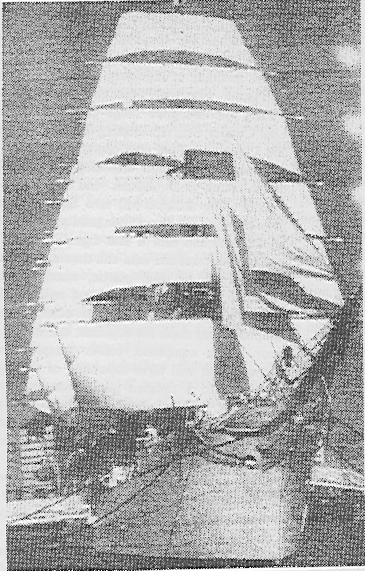 |
FAMOUS SHIPS |
 |
FAMOUS SHIPS |
THE "YOKOHAMA MARITIME MUSEUM "
The Yokohama Maritime Museum is very fortunate to have the sail training ship NIPPON MARU, but there are many other aspects of the museum, which will prove very interesting to any maritime enthusiast.
On July 1st, 1859, Yokohama was declared the first open port of Japan. The main cause of this was the arrival in 1853 and 1854 of American Matthew Perry’s squadron. Their mission was to open Japan’s doors to world trade. This led to Yokohama becoming the second largest city in Japan, which it is today. In 1989, the 130th anniversary of Yokohama Port and the 100th anniversary of the City of Yokohama, it was decided to have an aggressive waterfront redevelopment program. One aspect of this program was the opening of the Yokohama Maritime Museum on March 25th. The Museum and surrounding park occupies about 13 ˝ acres. The training ship NIPPON MARU is the main feature of this park
The NIPPON MARU is a four-masted barque with is 97 meters in length and a tonnage of 2,278 tons. She was used since 1930 as a training ship for 54 years, including WWII. During that time she trained approximately 11,500 seamen. The accumulated ships voyages over the years have taken her an equivalent of 45 ˝ times around the world, a record for a sailing ship. She is currently docked at the Mitsubishi Industries Company Yokohama Shipyard, which dates back to 1899 (formerly the Yokohama Dock Company) and is the oldest extant facility. No changes have been made to the NIPPON MARU, so the ship is presented in her original form. She is usually displayed with furled sails, but once a month her sails are set. She is beautifully displayed and even lit up at night until the park and museum close at 9:30 p.m.
The museum itself is engineered in a very unique way. Most of the museum is underground to best display the NIPPON MARU. From the air, one can see the NIPPON MARU and the open space near it. The museums roof is a gentle slope that looks like a lawn going toward the waters edge. The upper floor of the museum has a lobby, museum shop, restaurant, and exhibition hall. The underground main floor is very spacious, housing the exhibits in the central area, with additional space provided for special exhibits and a library.

From a modelers point of view, there are many fine examples of ship models on display in the museum, which adds to the sailors interest in this museum. There are many examples, but three are indicated here. The first is a model of the Edo-period sailing ship BENZAI-SEN. She was named for her cargo (rice bales) and the money earned from hauling this cargo. She was primarily used in the Inland Sea and combined both oar and sail until the Edo period. Design improvements then allowed her to move more swiftly by sail alone. This new feature enabled her to carry 2,000 bales of rice – twice her former load. There is the model of the passenger ship KAMAKURA MARU, from 1930 to 1943. She was the largest passenger ship prior to WWII and regularly sailed to San Francisco. She was she was requisitioned for WWII, renamed KAMAKURA MARU, and later sunk in action. A third model is of the cargo-passenger ship ARGENTINA MARU, 1939-48. She was the Yokohama based passenger ship which took round-the-world cruises. She had excellent fittings including ship levels that were tired like stairs and decking of a circular parquet design. She was also requisitioned during before WWII and converted to the aircraft carrier KAIYO.
There is a model of the ANDRE’ LEBON, which has special meaning to the people of Yokohama. She set sail in 1919 from Marseilles destined for Yokohama. The cargo/passenger ship belonged to the French Messageries Maritime Company. On the day of the great Kanto Earthquake, September 1, 1923, which almost resulted in to total destruction of Yokohama, ANDRE’ LEBON was berthed at the Osanbashi Pier. Quake victims were taken aboard the ANDRE’ LEBON and given shelter.
There are many other models of interest, many of which have not been seen in this country. It would be well worth any modelers effort to go to Yokohama to visit this museum if they are given a chance.